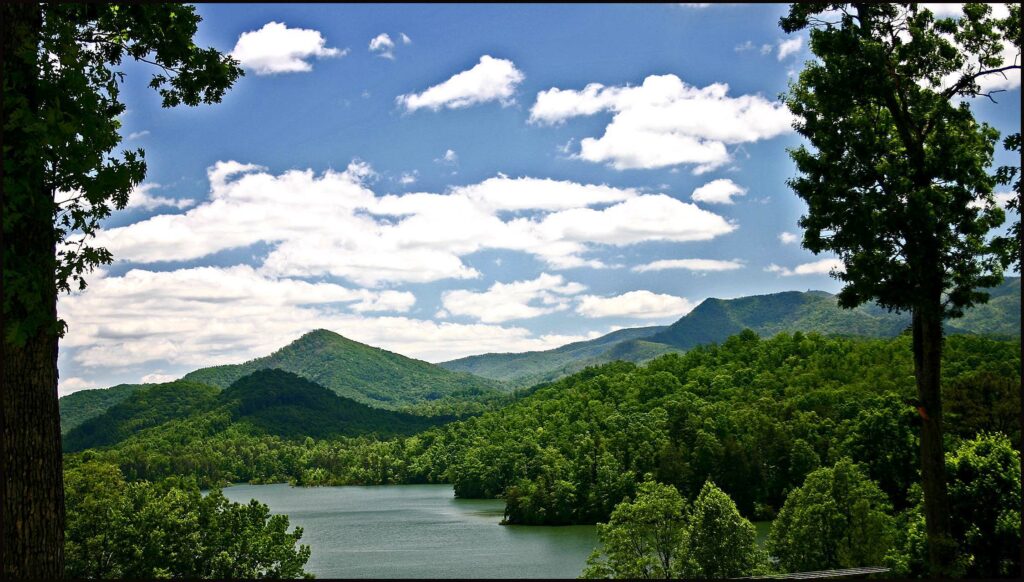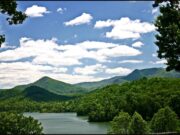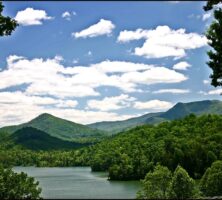Located on the shores of Lake Chatuge, a reservoir in northeast Georgia, Hiawassee serves as the county seat for Towns County.
Hiawassee is approximately 110 miles from Atlanta and just a few miles south of the North Carolina border. A quiet, rural town for most of its existence, several events during the twentieth century helped Hiawassee become an important part of the economy and culture of the north Georgia mountains.

The origins of Hiawassee can be traced to the mid-nineteenth century. In 1856 Towns County was created out of sections of neighboring Rabun and Union counties by an act of the state legislature. County officials, elected in April 1856, were responsible for selecting the location of the county seat. Although it is unknown when this decision was made, a courthouse had been built by 1857, and the town was incorporated under its original spelling of “Hiwassee” in 1870. The town’s location at the junction of foot trails formerly used by Native Americans may have led to the town’s name, which means “meadow” in Cherokee.
Like other towns in the north Georgia mountains, Hiawassee had few residents and little economic activity until the middle of the twentieth century. Located at the southern edge of the Blue Ridge Mountains, the area was not hospitable to staple crop farming, and its residents largely practiced subsistence agriculture. Around 1880 local farmers began selling off their land to northern timber companies, who clear-cut thousands of acres of north Georgia forest, reaping large profits but putting little of the money back into the local economy.
The transformation of Hiawassee started in 1937 with the creation of the Chattahoochee National Forest. Although the national forest had little immediate impact, it would play a role in the region’s transition to a tourism-based economy decades later. A more dramatic change occurred in 1941, when the Tennessee Valley Authority dammed the Hiwassee River to create Lake Chatuge, which straddles the border between Georgia and North Carolina. Although the creation of the lake submerged 3,500 acres of arable land in Georgia and displaced hundreds of local residents, the project also brought needed jobs into the area, which was still suffering economically from the Great Depression years of the 1930s. Once the project was completed, Hiawassee found itself located on the banks of the new lake.
Despite these changes, by 1950 Hiawassee remained largely poor and rural. The town and surrounding county had little arable land or industries, and roads remained largely unpaved. That year, however, local resident E. N. Nicholson organized a fair in Hiawassee. A three-day event, the first Georgia Mountain Fair was an agricultural exposition that also showcased skills and crafts from the region’s traditional mountain lifestyle. The fair proved successful and was expanded into a week-long event the next year. The event grew in popularity each year and has since become one of the largest annual events held in North Georgia, bringing thousands of visitors to the town and generating millions of dollars for the local economy.
Hiawassee now benefits from a tourism-based economy. The Georgia Mountain Fairgrounds holds several events throughout the year, including a bluegrass festival in the spring and the ten-day Georgia Mountain Fall Festival, the modern version of the original fair. The town is a stopping point for hikers and nature enthusiasts, who come to the area to enjoy the many miles of trails in the Chattahoochee National Forest, including the Appalachian Trail, which follows the eastern border of Towns County as it heads into North Carolina. The Fred Hamilton Rhododendron Garden is a popular tourist stop. It is the largest rhododendron garden in the state and is named for the local resident who developed the only domestic yellow azalea in existence. Lake Chatuge remains a popular destination for both boaters and fishers, and numerous campgrounds and resorts have sprung up around the lake’s shoreline.
Despite the growing number of regional attractions, Hiawassee remains a small town. According to the 2020 U.S census, the town, which occupies just over 2 square miles, had 981 permanent residents.






